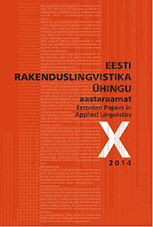Sissevaade varasesse eesti keele süntaksi omandamisse
INSIGHT INTO THE EARLY ACQUISITION OF SYNTAX IN ESTONIAN
Author(s): Airi KapanenSubject(s): Language and Literature Studies
Published by: Eesti Rakenduslingvistika Ühing (ERÜ)
Keywords: child language; repetition; support verb constructions; particles; Estonian
Summary/Abstract: This article examines syntax acquisition in Estonian on the basis of the spontaneous speech data of two children acquiring Estonian as their native language. The early utterances and the acquisition of syntax by children can be divided into three stages according to the strategy that a child uses to produce multi-word utterances: the use of antecedents, the particle period and the formation of the basic verbal argument structure constructions. The data indicates that Estonian children often use an extragrammatical operation, antecedents, while they iterate two- and multiword utterances. As children get older, the number of antecedents is gradually reduced and a substantial amount of particles and syntactically not bound two-word utterances appears. Simultaneously, child speech features some basic verbal argument structure constructions, subject-verb (SV), verb-object (VO) and subject-verb-object (SVO), and the number of such constructions increases gradually.
Journal: Eesti Rakenduslingvistika Ühingu aastaraamat
- Issue Year: 2014
- Issue No: 10
- Page Range: 139-155
- Page Count: 17
- Language: Estonian

